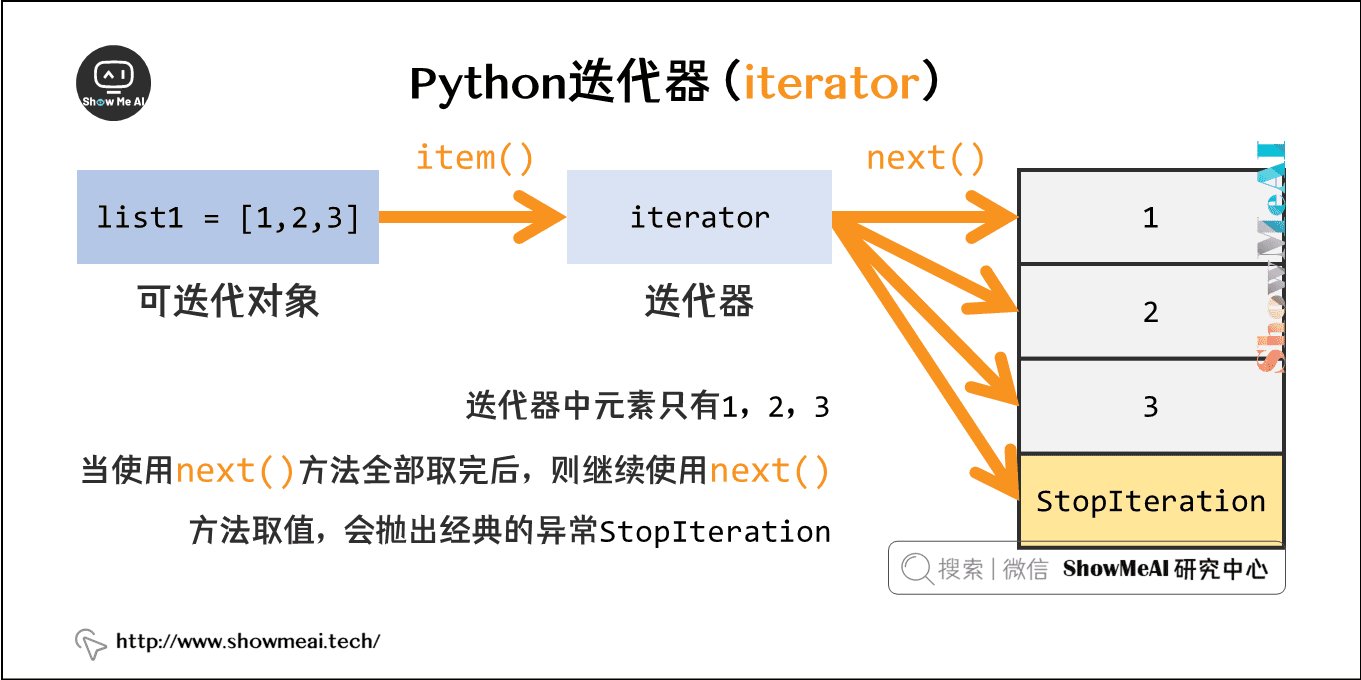
Tutorial address: http://www.showmeai.tech/tutorials/56
Article address: http://www.showmeai.tech/article-detail/82
Notice: All Rights Reserved. Please contact the platform and the author for reprint and indicate the source
1.Python iterator
Iteration is one of Python's most powerful features and a way to access collection elements.
An iterator is an object that remembers where to traverse.
The iterator object is accessed from the first element of the collection until all the elements are accessed. Iterators can only move forward, not backward.

Iterators have two basic methods: iter() and next().
String, list, or tuple objects can be used to create iterators:
list=[1,2,3,4] it = iter(list) # Create iterator object print(next(it)) # Next element of output iterator 1 print(next(it)) # Next element of output iterator 2
Iterator objects can be traversed using regular for statements( Online Python 3 environment):
l=['Baidu', 'ShowMeAI', 'google', 'ByteDance'] it = iter(l) # Create iterator object for x in it: print(x)
Execute the above procedures, and the output results are as follows:
Baidu ShowMeAI google ByteDance
You can also use the next() function( Online Python 3 environment):
list=['Baidu', 'ShowMeAI', 'google', 'ByteDance']
it = iter(list) # Create iterator object
while True:
try:
print(next(it))
except StopIteration:
breakExecute the above procedures, and the output results are as follows:
Baidu ShowMeAI google ByteDance
(1) Create an iterator
To use a class as an iterator, you need to implement two methods iter() and next() in the class.
If you already know about object-oriented programming, you know that classes have a constructor. Python's constructor is init(), which will be executed when the object is initialized.
For more information: Python object oriented
The iter() method returns a special iterator object that implements the next() method and identifies the completion of the iteration through the StopIteration exception.
The next() method (next() in Python 2) returns the next iterator object.
Create an iterator that returns a number, with an initial value of 1 and incremented by 1( Online Python 3 environment):
class IterNumbers:
def __iter__(self):
self.a = 1
return self
def __next__(self):
x = self.a
self.a += 1
return x
num_class = IterNumbers()
iter_num = iter(num_class)
print(next(iter_num))
print(next(iter_num))
print(next(iter_num))
print(next(iter_num))
print(next(iter_num))The execution output is:
1 2 3 4 5
(2)StopIteration
The StopIteration exception is used to identify the completion of the iteration and prevent infinite loops. In the next() method, we can set the StopIteration exception to be triggered after completing the specified number of cycles to end the iteration.
Stop execution after 10 iterations( Online Python 3 environment):
class IterNumbers:
def __iter__(self):
self.a = 1
return self
def __next__(self):
if self.a <= 10:
x = self.a
self.a += 1
return x
else:
raise StopIteration
num_class = IterNumbers()
iter_num = iter(num_class)
for x in iter_num:
print(x)The execution output is:
1 2 3 4 5 6 7 8 9 10
2. Generator
In Python, functions that use yield are called generator s.
Unlike ordinary functions, a generator is a function that returns an iterator and can only be used for iterative operations.

In the process of calling the generator to run, the function will pause and save all the current running information every time it encounters yield, return the value of yield, and continue to run from the current position the next time it executes the next() method.
Call a generator function and return an iterator object.
The following example uses yield to implement Fibonacci sequence( Online Python 3 environment):
def fibonacci(n): # Generator function - Fibonacci
a, b, counter = 0, 1, 0
while True:
if (counter > n):
return
yield a
a, b = b, a + b
counter += 1
f = fibonacci(10) # f is an iterator that is returned by the generator
while True:
try:
print(next(f))
except StopIteration:
breakExecute the above procedures, and the output results are as follows:
0 1 1 2 3 5 8 13 21 34 55
3. Video tutorial
Please click to station B to view the version of [bilingual subtitles]
https://www.bilibili.com/video/BV1yg411c7Nw
Data and code download
The code for this tutorial series can be found in github corresponding to ShowMeAI Download in, you can run in the local python environment. Babies who can surf the Internet scientifically can also directly use Google lab to run and learn through interactive operation!
The Python quick look-up table involved in this tutorial series can be downloaded and obtained at the following address:
Extended references
ShowMeAI related articles recommended
- Introduction to python
- python installation and environment configuration
- python basic syntax
- python basic data type
- python operator
- python conditional control and if statement
- python loop statement
- python while loop
- python for loop
- python break statement
- python continue statement
- python pass statement
- python string and operation
- python list
- python tuple
- python dictionary
- python collection
- python function
- python iterators and generators
- python data structure
- python module
- python file reading and writing
- python file and directory operation
- python error and exception handling
- python object oriented programming
- python namespace and scope
- python time and date
ShowMeAI series tutorial recommendations
- Illustrated Python Programming: a series of tutorials from getting started to mastering
- Graphic data analysis: a series of tutorials from introduction to mastery
- Fundamentals of graphic AI Mathematics: a series of tutorials from introduction to mastery
- Illustrated big data technology: a series of tutorials from introduction to mastery
